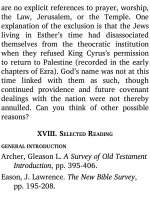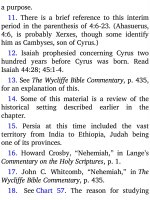Jensens survey of the old testament adam 96
Bạn đang xem bản rút gọn của tài liệu. Xem và tải ngay bản đầy đủ của tài liệu tại đây (131.84 KB, 4 trang )
titles.)
3. Refer to Chart 35 and note the chapter
spread of the references to the judges.
Where on Chart 36 does this grouping
appear?
4. Study the survey Chart 36 carefully.
Read 1:1—3:6 and observe how these
chapters serve as an introduction to the
main body of the book. Why is a main
division made at 3:7?
5. According to Chart 35, who is the last
judge appearing in this book? What chapter
is the last to report about him? Use this as a
clue to explain why a new division is made
at chapter 17 on the chart.
6. The long section 3:7—16:31 is one
continuous story of deliverances and
setbacks. How does the bottom of the chart
relate 1:1—3:6 and 17:1—21:25 to this?
7. Note the contrast between the
beginning of the book— ghting the enemy
—and the end—fighting a brother.
IV. PROMINENT SUBJECTS
(3:7—16:31)
According to Chart 36, a comparatively
large space of the Bible text is devoted to
three judges, Deborah, Gideon, and Samson.
Many are the Bible stories which have been
written about these interesting leaders. But
all the judges of Israel had the equally
responsible task of delivering the nation
from six successive foreign oppressions.
These are cited in the next section (B).
A. THE JUDGES
B. THE CYCLE OF ISRAEL’S RELIGIOUS EXPERIENCE
A pattern of religious experience, which
might be called a cycle, appears again and
again in the book of Judges. The following
diagram illustrates this cycle.
Read 2:16-19 to see the pattern of this
cycle.
1. Rest. During Joshua’s lifetime and for
some years afterward, Israel served God and
enjoyed the blessings of their rest land. This
is where the book of Judges begins.
2. Rebellion. When a new generation arose,
they divorced themselves from God and, in
rebellion against Him, took on the ways of
the idolatrous Canaanites.
3. Retribution. Just as He had said He
would, God withdrew His protection and
power from Israel and delivered them into
the hands of foreign oppressors.
4. Repentance. Then the Israelites repented
of their sin and cried to God for help. (In
2:16 this is only implied; read 3:9 for a
fuller statement. Read also 10:10, KJV, to
see what was involved when they “cried
unto the LORD.”)
5. Restoration. God raised up a judge to
deliver His people from their oppressor and
to lead them back to a life of fellowship with
Him—back to the beginning of the cycle,
rest.
The cycle accentuates two prominent lines
of truth: (1) the desperate sickness of the
human heart, revealing its ingratitude,
stubbornness, rebellion, and folly; and (2)
God’s long-su ering, patience, love, and
mercy. (The prominence of the Lord in the
narrative of Judges is shown by the fact that
the name “LORD” appears 178 times and
“God” 62 times in the book.)









